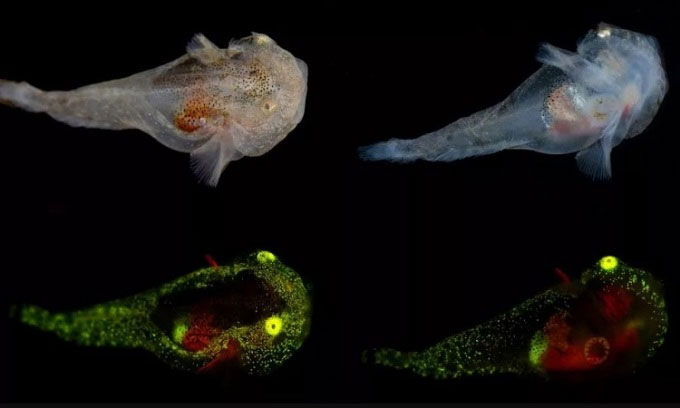Fish filled with antifreeze live under icebergs
Scientists drilled deep beneath an iceberg off the coast of Greenland and discovered fish with a green luminescent antifreeze flowing through its blood vessels.
Immature spotted snailfish (Liparis gibbus) contain the highest amount of antifreeze protein ever recorded, according to the study published August 16 in the journal Evolutionary Bioinformatics. Just as antifreeze helps regulate car engine temperatures in extreme conditions, some species have evolved with similar abilities, especially creatures that live in frigid environments like the polar seas off Greenland.

Snail fish photographed under white light.
"Antifreeze proteins adhere to the surface of smaller ice crystals, preventing them from growing into larger and more dangerous crystals," said study co-author David Gruber, a professor of biology at New York University's Baruch School. , said. "Fish from both Antarctica and the Arctic have evolved this protein independently of each other."
Antifreeze proteins were first discovered in some Antarctic fish nearly 50 years ago, according to the National Science Society. Unlike many cold-blooded reptiles and insects, fish cannot survive when their body fluids freeze, causing ice particles to form inside their cells. Snails produce an anticoagulant protein like any other protein, which is then secreted into the bloodstream, according to Gruber.
Scientists found the spotted snailfish in 2019 during an expedition while exploring an iceberg off the coast of Greenland. During the trip, they were amazed to see green and red bioluminescent snailfish in the ice environment. "Snailfish are one of the few fish species that live among icebergs, in small cavities. It's surprising that such a small fish can live in extreme cold without freezing," Gruber said. .
Arctic fish very rarely exhibit bioluminescence, the ability to transform blue light into green, red or yellow, due to the prolonged darkness of the polar winter. Usually, this characteristic is found in fish that swim in warm waters.
The team examined the bioluminescence characteristics of snail fish and found two different genes that encode antifreeze proteins, an adaptation that prevents them from turning into frozen fish. The extremely high amount of antifreeze protein can help snail fish adapt to an environment below 0 degrees Celsius. However, experts are not sure how they will survive when ocean temperatures increase due to global warming.
- The price to pay for the fish that live in Antarctica
- Find the 'hot' fish living in Antarctica
- Strange fish can live on land all year without dying
- Animal mining technologies, better than people
- Learn species of jaws filled with mysterious sharp teeth
- Antarctic Antarctic fish is about to be extinct
- Discovering fish is evolving to prepare water to live on shore
- Saltwater fish can live in fresh water?
- Antarctic fish's blood has antifreeze
- Ice mountains 'disrupt' ecological diversity in the Antarctic seabed
- Fleas pave the way for organ transplantation techniques
- Techniques for raising fish in slices
 Animal 'suffering' after hibernation
Animal 'suffering' after hibernation Why do goats climb well?
Why do goats climb well? Scientists were surprised to see chimpanzees eating turtles
Scientists were surprised to see chimpanzees eating turtles Giant catfish died deadly due to drought in Thailand
Giant catfish died deadly due to drought in Thailand